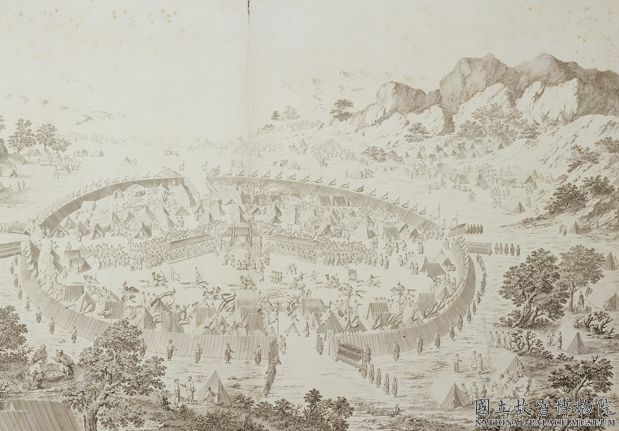[Xiao Yuncong Xue Yue Reading Map Axis]
Xue Yue Reading Map Axis, Ming Dynasty, Xiao Yuncong painting, paper, color, vertical 125.3 cm, horizontal 47.7 cm
This is a seven-character poem with the title of “Ren Chen Changzhi, who made a picture of Xueyue reading for the social alliance. When he heard the good voice of Sanqin, he attached this song for teaching. Zhong Shanmei’s younger brother Xiao Yuncong.” The seal “Xiao Yuncong” and “Chi Muzi” were printed in two directions. “Ren Chen” is the ninth year of Shunzhi in the Qing Dynasty (1652), when the painter was 57 years old
Xiao Yuncong’s landscape paintings have various styles, but the basic feature that runs through them is that the strokes and ink are folded and thin in many ways, and some chaps are added to the bone body of the square fold, rendering slightly, which makes the strokes and ink rich and flexible. At that time, Songjiang School painting was popular in the painting world. Its paintings were soft lines and beautiful ink, while Xiao Shi changed to straight lines and thin and sharp ink, which was unique. The Commentary on Xiao Yuncong’s paintings in The Collection of Paintings of the National Dynasty said: “He is not specialized in the patriarchal clan system, but has his own family, and the pen is also clear and happy.” This shows the key to Xiao Yuncong’s painting style. His paintings are not specific to a certain patriarchal clan, but it can be seen that they have evolved from the painting methods of the Song and Yuan Dynasties. Although this picture depicts a snow scene with a slightly different way of expression than usual, the typical features of Xiao’s paintings can still be seen
The picture uses the high and far method to depict the rock and the cliff. The layout is full, but the fluffy branches of the dense trees in the mountains make the picture full, but it is not crowded. The stone outline is relatively square and hard, and the chapped brush at the depression is exquisite; The trees are also exquisitely carved, and the brush is fine, vigorous and fast, and the texture of the trunk and the shape of the leaves are meticulously described. The ground is cleverly left blank to show the snow on large areas of rocks and tree branches. The white snow is more and more quiet and bleak against the gloomy sky with faint ink. However, several Shun bamboos occasionally appear at the foot of the tree and the stone gap in the close view. The branches of the tree are stained with rattan yellow, and the leaves are painted with vermilion and juicy green respectively. All of these make the viewer feel the vitality hidden in the chill atmosphere of winter, which can be said to be unique in the past snow scenery works. On the one hand, it is because the author has a unique feeling of nature, and it also shows Xiao Yun’s hope surging from his heart
At that time, the kings of the imperial family of the Ming Dynasty were in exile. In addition to the main regimes such as Hongguang, Longwu and Yongli, there were still many and influential subjects who fought against the Qing Dynasty. As a survivor of the Ming Dynasty, Xiao always pays close attention to these events. In the title recognition, “when the sound of Sanqin is good” seems to refer to such events
Xiao Yuncong once studied Du Fu’s poems and wrote a volume of Du Lv Xi. His poems also inherit the tradition of Du Fu’s poems, which are often made by worrying about the times, such as the picture-themed poems. In the poem, “the emperor’s cloud rises across the Weihe River”, “the general sings a song of the wind” and other sentences are more vigorous and unrestrained, with sonorous sound, and reflect each other with the picture, which truly shows Xiao Yuncong’s thoughts and feelings as a survivor of the Ming Dynasty.
![图片[1]-Xiao Yun reads the scroll from Xueyue-China Archive](https://chinaarchive.net/Ming dynasty/painting/s5bff5378012df.jpg)

![[Qing Dynasty] British female painter—Elizabeth Keith, using woodblock prints to record China from the late Qing Dynasty to the early Republic of China—1915-China Archive](https://chinaarchive.net/wp-content/uploads/2022/11/image-191x300.png)



